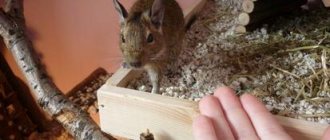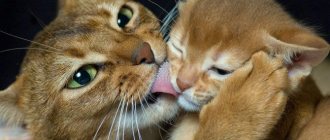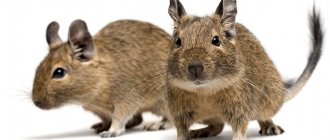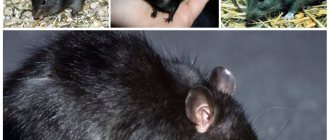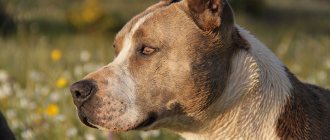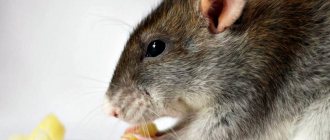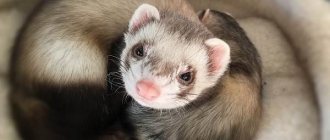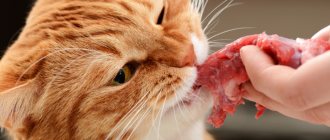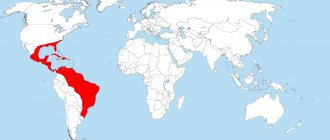General information about degus
In their natural habitat, degus can be found in the open steppe zones of many South American countries (for example, Brazil, Chile, Peru). Distinctive external features of these rodents are:
- head - round, small;
- eyes - coal-black, widely set;
- ears - semicircular, directed upward;
- paws - small, thin with sharp black claws;
- the coat is thick, in places it fits tightly to the body;
- the tail is long (relative to the body), its size is 6-10 cm, it peels off under strong mechanical stress and after a while grows back, almost like a lizard’s;
- color - reddish-brown with a light yellow transition on the lower part of the abdomen;
- weight - up to 350 g;
- height - 15-20 cm.
The average life expectancy is 6-8 years in captivity and 1-2 years in the wild.
cute little animal lives longer at home than in the wild
What to name the animal
In the wild, Degus try to avoid direct sunlight
The natural habitat for Degu squirrels is South American rocky areas covered with bushes. Such biotopes can be found in the territories of Bolivia, Chile, Peru and Argentina.
Bush rats are predominantly diurnal, preferring to forage for food and move around in the morning and evening. This is because direct sunlight and high temperatures can cause heat stroke in them.
Being herbivores, Degus feed mainly on grass, leaves, roots and bark. The diet also includes small amounts of grains and fresh fruits. Food for the winter is stored in burrows.
The natural color of Degus is known in two types: gray-brown and yellow-brown. People artificially bred spotted, sand and blue degus.
Regardless of color, all representatives of the species have the same physique. The length of the body is 10–20 cm, the tail can reach 10 cm and has a tassel at the end. The weight of healthy adult individuals ranges from 100–500 g. Degus fur is short, but soft and pleasant to the touch.
Like all rodents, Degus' teeth grow throughout their lives, so the animals have to constantly grind them down. Degus have a total of 20 teeth.
Funny names with the suffix -ik work well for degus
When choosing a name for a pet, owners usually pay attention to the external features of the animal and its characteristic behavioral habits. This is where popular nicknames like “Shustrik”, “Ryzhik”, etc. come from.
Owners often draw names for their pets from movies or books, calling their charges “Bonnie and Clyde” (popular for a couple of Degus), “Rick and Morty”, etc.
Scientists have found that all rodents are better suited to nicknames that begin with the letters Z, C or S. It is these sounds that Degus perceive best, which means your pets will respond to their name faster.
Animal character
Degus have high intellectual abilities, are easy to train, and some individuals are able to respond to their own nickname. They quickly become tame and are happy to interact with small children. It is also important to explain to your child that you should not pull your pet’s tail, otherwise it may be damaged. Chilean squirrels are incredibly active and energetic. Unlike other rodents, degus are diurnal and sleep at night. It is not recommended to keep these animals together with cats and large breeds of dogs.
the pet is trainable
Pros and cons of keeping a Degu as a pet
Before getting a pet, much less an exotic South American rodent, future owners need to weigh the pros and cons.
Only after studying the features of caring for the animal, its habits and possible problems in its maintenance, should a final decision be made.
Benefits of keeping Degu squirrels:
- It's fashionable. Bored ferrets and chinchillas have faded into the background, now South American bush rats are at the peak of popularity;
- Degus take up little space. Unlike dogs or cats, small rodents do not require the space of an entire apartment; a cage of very modest dimensions is enough for them;
- High intelligence and sociability. Degus breeders claim that their pets have the highest intelligence among rodents. This is a controversial issue, but there is no doubt that Degu domestic squirrels are very sociable and attached to humans;
- Daytime lifestyle. Anyone who has experience keeping rodents at home knows their habit of gnawing on cage bars, “talking” loudly and making noise at night. Degus sleep at night and will not disturb their owners;
- Little smell. Degus consume little liquid and also excrete little. The cage needs to be cleaned regularly in any case, but if Chilean squirrels live in it, then this will have to be done much less often.
Negative aspects of keeping Degu:
- It's a question of price. Baby Degu squirrels are sold from 500 rubles per head; adult individuals are offered for 1,500–2,000 rubles. In addition to purchasing the animal itself, you will have to spend money on equipping the cage with all the necessary accessories, expensive special food and veterinary care. On average, maintaining a pair of squirrels costs owners at least 2000–3000 rubles monthly;
- Noise and trash. Despite their diurnal lifestyle, in which domestic Degus do not disturb their owners at night, during the day the pets produce quite a lot of noise and debris. Therefore, lovers of silence and ideal cleanliness should abandon their idea of owning these particular animals;
- An insatiable thirst for destruction. Degus are primarily rodents, which means they will destroy and smash everything around that catches their eye. Owners of Chilean squirrels should prepare to constantly replace the interior of the cage. If the animal is occasionally walked outside the cage, then absolutely all pieces of furniture and household items may be damaged.
If you give Degus enough time, they can learn some funny tricks.
Degus are highly trainable. To raise rodents, you will need some free time and treats allowed for pets (berries, dry corn, etc.).
We suggest you read: What to feed ducklings in the first days of life
Here are some popular tricks that are easy to teach to an animal:
- "Dance" command. Taking a treat in your hand, you need to attract the Degu’s attention and rotate it in one direction in a circular motion over the rodent’s head. When Degus performs a dance spin after the treat, you should give him the treat. During training, try to repeat the “dance” command loudly and clearly.
- Command "here". Simply luring the rodent with a piece of treat to the desired place and repeating the command “here”, you will soon notice that the pet will carry out the command without reward.
- Jump command. Having placed the Degu on one knee and moving the other one to the side a short distance, lure the animal with a treat on the far knee, loudly repeating the command. When your pet jumps over the distance, reward him by giving him a treat and petting him behind the ear.
By spending more time with your pet, you will quickly find a common language with him and be able to teach him many tricks and commands.
How to choose a healthy baby squirrel?
The optimal age for baby squirrels to be kept in a cage is 2-3 months. The fact is that before this period, babies need mother's milk; they are not capable of digesting coarser food. It’s definitely not possible to create such feeding conditions at home, otherwise you will have to syringe feed the baby. When purchasing a degu, be sure to carry out the following visual inspection:
- eyes - without a cloudy veil, clear;
- nose - dry, dark gray, without mucous discharge;
- the coat is clean, without dandruff, tangles and lumps;
- skin - without inflammation, wounds, scratches and peeling;
- the spine is straight, not curved or protruding;
- behavior - active, cheerful, curious.
Buy a rodent only from experienced breeders, as well as from well-known nurseries. Pay attention to the conditions in which the children and their parents are kept, what the animals are fed, and whether the rules and regulations of care are followed. Be sure to ask the seller for the following supporting documentation:
- veterinary health passport;
- pedigree;
- breeding permit;
- contract of sale.
How to make a diet
The entire degu diet is prepared based on a week. After all, for example, fats are given to rodents every other day. It is also very important to correctly calculate the amount of proteins, fats and carbohydrates per week. Do not forget about the various sources of vitamins, trace elements and minerals.
Degus should have water constantly; it should be changed every other day. It is best to use boiled, filtered or bottled drinking water. Hay and mineral supplements must be kept in the cage at all times.
A degu is a cheerful and active animal that, with proper care, will respond to you with mutual love and devotion and will live a full life with you for many years.
Conditions of detention
Cell
For comfortable living of a rodent, you will need a spacious enclosure, the length of which is 1 m, height 1 m, and width - 70 cm. The minimum distance between the bars is 1-1.5 cm, so that the little squirrel cannot get out without the knowledge of the owners. The rods must be made of durable metal, and the bottom must be made of plastic that does not have sharp corners or parts, in order to avoid injury to the animal. Do not place the cage near heating appliances, heaters or near a window. Optimal location: the middle part of the room, protected from drafts and bright scorching sun.
a comfortable cage should contain everything necessary for a pet’s comfortable and interesting life
Feeder
Degus love to chew on everything that gets in their way. Therefore, the feeder should be made exclusively of stainless steel. Choose products with a special hanging mount so that a cunning pet cannot knock over the bowl of food. The average diameter of a container for an adult animal is 8-10 cm.
Drinking bowl
Provide your pet with clean drinking water: boiled, filtered or still mineral water. The best option for a degu drinker is a drip model that is attached directly to the cage. There is a metal ball hidden inside the sippy cup, which rises when pressed lightly, allowing water to pass through. The body of the product can be plastic or glass.
Carrying
Transporting a small, defenseless degu should be carried out in a small plastic carrier with an open mesh front so that the pet can see everything that is happening around. Pay attention to how tightly the door closes, in order to prevent the possible escape of a cunning rodent.
Sand bath
Chilean squirrels prefer to clean their coats by bathing in special mineral sand. To carry out this procedure, place a corner plastic container in the enclosure with sides up to 10 cm high. Remove the bath periodically, changing the contents.
The sand-mineral mixture for degu is divided into several types.
- Sepiolite - has excellent lyophilic properties, due to which the smallest dust particles and dirt particles accumulate in one place. When exposed to liquid, this sand may clump.
- Palygorskite is absolutely dust-free and perfectly absorbs excess moisture.
- Zeolite is the basis for the production of most modern “zoo” fillers.
Any of the above types of sand mixture is ideal for pet squirrels. Their main difference is the price.
Litter
Depending on the purpose, bedding for rodents is divided into 2 types:
- for absorbing unpleasant odors - sawdust, torn paper, silica gel granules are suitable;
- for playing and digging - straw, hay, small pebbles, twigs, and snags would be an excellent option.
Change the filler periodically to avoid the occurrence of infectious diseases.
Wooden house
Sometimes a little squirrel needs privacy. Organize a small wooden house for your pet. The product can be either single-story or multi-tiered with various transitions and paths. Place some soft bedding inside the shelter to create a safe and cozy atmosphere.
Wheel
Mobility and energy are the main criteria for a happy life for the degu squirrel. Therefore, for proper physical development, install a metal wheel in the enclosure that matches the size of your pet. Check that the “sports equipment” is securely fastened to avoid injury to the animal.
Comb
The thick, dense fur of the Chilean squirrel requires constant care. Buy a slicker comb to comb out accumulated hairballs and tangles formed as a result of vigorous activity.
Claw cutter
As they grow, trim the degu's thin claws with special nail clippers that have a rounded, beveled edge. This product is made of strong stainless steel. Before carrying out the procedure, be sure to treat the manicure device in an alcohol solution to avoid infection.
Emergency kit
Unfortunately, there are often situations when the owner must provide emergency first aid to his pet. This may require the following medications and improvised means:
- sterile bandage and cotton wool;
- antibacterial patch;
- Digital Thermometer;
- iodine, brilliant green;
- tweezers, syringe;
- activated carbon is an absorbent;
- oak bark - for diarrhea;
- Lactobacterin - against dysbacteriosis;
- Duphalac - for constipation;
- Tetracycline - against inflammation of the eye mucous membranes;
- Macmiror - from parasitic infection;
- Triderm is an antifungal agent;
- Chlorhexidine - for washing wounds;
- Kalegel - pain reliever;
- Echinacea - immunostimulating;
- Gepar Compositum - to maintain proper liver function;
- Cyston - for renal colic.
What to feed your degu squirrel?
Main dietary requirements
Let's look at the basics of feeding degu squirrels.
- The menu should be as balanced, nutritious and healthy as possible.
- Feed your pet no more than 2-3 times a day. The volume of one serving is 50-100 g. (depending on age indicators). Never overfeed your rodent, otherwise serious digestive problems may occur.
- Alternate natural foods with dry grain mixtures.
- Change the water in the sippy cup daily.
- Add to your diet various vitamin complexes with a high calcium content, which is necessary for proper growth and development of the musculoskeletal system.
Grain mixtures
Ready-made grain mixtures are enriched with all necessary vitamins, minerals, macro and microelements. The following brands are considered the most popular:
- Little One;
- Versele-Laga Nature;
- JR Farm Classic Feast;
- Fiory;
- Beaphar Care;
- Vitakraft.
Natural nutrition
The “natural” degu protein menu should contain the following products:
- cereals - buckwheat, corn, oatmeal, flaxseed, rice, quinoa;
- legumes - lentils, chickpeas, peas;
- seeds - sesame, canary, poppy, hemp, quinoa, rapeseed, dill, fennel;
- berry fruits - cherry plum, gooseberry, hawthorn, raspberry, sea buckthorn, rowan, plum, currant;
- fruits - kiwi, pear, quince;
- vegetables - beets, carrots, zucchini, pumpkin, bell pepper, cucumber, cauliflower, eggplant;
- nuts - almonds, cashews, hazelnuts, walnuts;
- seeds - pumpkin, watermelon, squash, sunflower;
- roots - celery, chicory, parsnip.
Prohibited Products
It is strictly forbidden to introduce the following into the diet of rodents:
- bakery products;
- cakes, sweets, pastries;
- bananas;
- raisins and dates;
- any meat and fish;
- dairy products;
- citrus;
- mushrooms, garlic;
- pickles, smoked meats, spicy dishes.
What diseases threaten the Chilean squirrel?
Small, defenseless degus are most often attacked by the diseases described below.
- Conjunctivitis - purulent discharge appears near the mucous canals, the eyelids swell and turn red. For treatment, use Ciprovet or Tobrex drops.
- Cataracts - manifests itself in mature and elderly rodents. The appearance of a whitish spot on the eyeball is the first sign of the disease. Unfortunately, there are no ways to eliminate the disease.
- Diarrhea - liquid stool, a grumbling stomach in a pet, anxiety and excessive fuss - are the main symptoms of an intestinal disorder. Give any antidiarrheal drug in a pediatric dose.
- Skin fungus - any redness, peeling or bald spots on the skin can be caused by a fungal infection. The doctor will prescribe treatment.
Caring for degu squirrels will not cause unnecessary hassle or problems. The main thing is to follow all the rules and regulations for keeping and feeding rodents, and then these charming creatures will delight you for a long time. Before using any medications, consult a veterinarian.
Features of degu care
It is important to know that these cute furry animals are very prone to diabetes, so special attention must be paid to the proper nutrition of your pet. Do not offer degus sweets or food that is intended for other animals. Hamsters and gerbils are completely different rodents with their own feeding habits. The exception is, as already mentioned, food for chinchillas, preferably premium.
Another feature of degus is the constant growth of teeth. Just like other rodents, squirrels vitally need grinding. Offer your squirrel dry twigs of non-poisonous shrubs and trees (except plums, cherries, apricots and other stone fruit plants).
As an alternative, you can offer the squirrel mineral stones, which are great for helping furry rodents grind down their teeth.
As you can see, caring for a degu is not too difficult or troublesome. But it is necessary to adhere to the basic principles, in this case the degu will delight you with its company for a long time!
